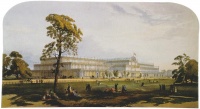Glass
From The Art and Popular Culture Encyclopedia

|
Related e |
|
Featured: |
Glass is an amorphous (non-crystalline) solid material. Glasses are typically brittle and optically transparent.
The most familiar type of glass, used for centuries in windows and drinking vessels, is soda-lime glass, composed of about 75% silica (SiO2) plus Na2O, CaO, and several minor additives. Often, the term glass is used in a restricted sense to refer to this specific use.
In science, however, the term glass is usually defined in a much wider sense, including every solid that possesses a non-crystalline (i.e., amorphous) structure and that exhibits a glass transition when heated towards the liquid state. In this wider sense, glasses can be made of quite different classes of materials: metallic alloys, ionic melts, aqueous solutions, molecular liquids, and polymers. For many applications (bottles, eyewear) polymer glasses (acrylic glass, polycarbonate, polyethylene terephthalate) are a lighter alternative to traditional silica glasses.
Glass, as a substance, plays an essential role in science and industry. Its chemical, physical, and in particular optical properties make it suitable for applications such as flat glass, container glass, optics and optoelectronics material, laboratory equipment, thermal insulator (glass wool), reinforcement materials (glass-reinforced plastic, glass fiber reinforced concrete), and glass art (art glass, studio glass).
History
The history of creating glass can be traced back to 3500 BCE in Mesopotamia. The term glass developed in the late Roman Empire. It was in the Roman glassmaking center at Trier, now in modern Germany, that the late-Latin term glesum originated, probably from a Germanic word for a transparent, lustrous substance.


